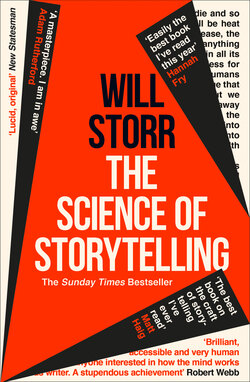Читать книгу The Science of Storytelling - Will Storr, Уилл Сторр - Страница 11
1.2
ОглавлениеUnexpected change isn’t the only way to arouse curiosity. As part of their mission to control the world, brains need to properly understand it. This makes humans insatiably inquisitive: nine-week-old babies are drawn to, unfamiliar images over ones they’ve seen before; between the ages of two and five, it’s thought children ask around 40,000 ‘explanatory’ questions of their caregivers. Humans have an extraordinary thirst for knowledge. Storytellers excite these instincts by creating worlds but stopping short of telling readers everything about them.
The secrets of human curiosity have been explored by psychologists, perhaps most famously by Professor George Loewenstein. He writes of a test in which participants were confronted by a grid of squares on a computer screen. They were asked to click five of them. Some participants found that, with each click, another picture of an animal appeared. But a second group saw small component parts of a single animal. With each square they clicked, another part of a greater picture was revealed. This second group were much more likely to keep on clicking squares after the required five, and then keep going until enough of them had been turned that the mystery of the animal’s identity had been solved. Brains, concluded the researchers, seem to become spontaneously curious when presented with an ‘information set’ they realise is incomplete. ‘There is a natural inclination to resolve information gaps,’ wrote Loewenstein, ‘even for questions of no importance.’
Another study had participants being shown three photographs of parts of someone’s body: hands, feet and torso. A second group saw two parts, a third saw one, while another group still saw none. Researchers found that the more photos of the person’s body parts the participants saw, the greater was their desire to see a complete picture of the person. There is, concluded Loewenstein, a ‘positive relationship between curiosity and knowledge’. The more context we learn about a mystery, the more anxious we become to solve it. As the stories reveal more of themselves, we increasingly want to know, Where is Spot? Who is ‘Bunny’ and how did he die and how is the narrator implicated in his death?
Curiosity is shaped like a lowercase n. It’s at its weakest when people have no idea about the answer to a question and also when entirely convinced they do. The place of maximum curiosity – the zone in which storytellers play – is when people think they have some idea but aren’t quite sure. Brain scans reveal that curiosity begins as a little kick in the brain’s reward system: we crave to know the answer, or what happens next in the story, in the way we might crave drugs or sex or chocolate. This pleasantly unpleasant state, that causes us to squirm with tantalised discomfort at the delicious promise of an answer, is undeniably powerful. During one experiment, psychologists noted archly that their participants’ ‘compulsion to know the answer was so great that they were willing to pay for the information, even though curiosity could have been sated for free after the session.’
In his paper ‘The Psychology of Curiosity’, Loewenstein breaks down four ways of involuntarily inducing curiosity in humans: (1) the ‘posing of a question or presentation of a puzzle’; (2) ‘exposure to a sequence of events with an anticipated but unknown resolution’; (3) ‘the violation of expectations that triggers a search for an explanation’; (4) knowledge of ‘possession of information by someone else’.
Storytellers have long known these principles, having discovered them by practice and instinct. Information gaps create gnawing levels of curiosity in the readers of Agatha Christie and the viewers of Prime Suspect, stories in which they’re (1) posed a puzzle; (2) exposed to a sequence of events with an anticipated but unknown resolution; (3) surprised by red herrings, and (4) tantalised by the fact that someone knows whodunnit, and how, but we don’t. Without realising it, deep in the detail of his dry, academic paper, Loewenstein has written a perfect description of police-procedural drama.
It’s not just detective stories that rely on information gaps. John Patrick Shanley’s Pulitzer Prize-winning stage play Doubt toyed brilliantly with its audience’s desire to know whether its protagonist, the avuncular and rebellious Catholic priest Father Flynn, was, in fact, a paedophile. The long-form journalist Malcolm Gladwell is a master at building curiosity about Loewensteinian ‘questions of no importance’ and manages the feat no more effectively than in his story ‘The Ketchup Conundrum’, in which he becomes a detective trying to solve the mystery of why it’s so hard to make a sauce to rival Heinz.
Some of our most successful mass-market storytellers also rely on information gaps. J. J. Abrams is co-creator of the longform television series Lost, which followed characters who mysteriously manage to survive an airline crash on a South Pacific island. There they discover mysterious polar bears; a mysterious band of ancient beings known as ‘the Others’; a mysterious French woman; a mysterious ‘smoke monster’ and a mysterious metal door in the ground. Fifteen million viewers in the US alone were drawn to watch that first series, in which a world was created then filled until psychedelic with information gaps. Abrams has described his controlling theory of storytelling as consisting of the opening of ‘mystery boxes’. Mystery, he’s said, ‘is the catalyst for imagination … what are stories but mystery boxes?’
